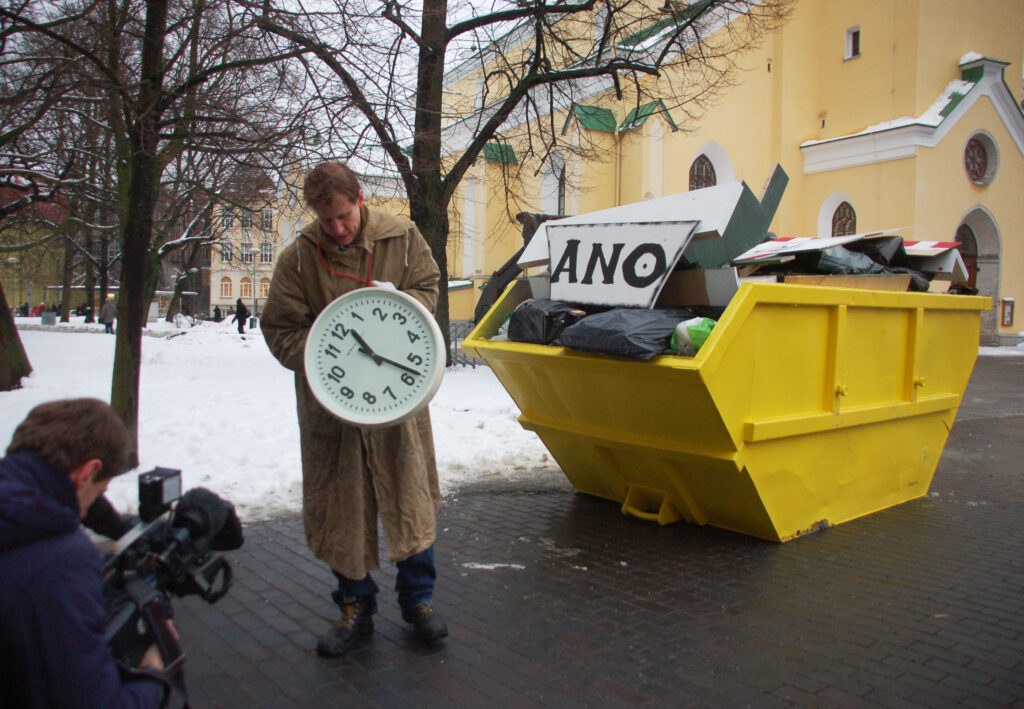
Erki Kasemets (1969) is an artist working with installation, painting, performance and theatre. His work includes trash art, polygon theatre performances, systematic documentation of personal life, focus on material, kinetic art, set and stage design, and activities in artist groups Vedelik and P.E.A.. Kasemets views his practice and method as bricolage, often creating art works from broken, useless or discarded everyday objects. Many of his works address themes like time and memory from a subjective standpoint.
Kasemets began exhibiting in early 1990s when studying scenography in the Estonian Academy of Arts. The Estonian public mainly knows him for his work in trash art. Among the first objects that found a place in Kasmets’ work and which he started collecting were one-litre milk cartons. The project “Life-file” presents empty painted milk cartons with dates or text that mark certain dates in the artist’s life. In that sense, Kasemets’ practice of trash art is cumulative, process-based and evolving in time – the collected objects are like units of data. As such, use of rubbish in his works is not a critique of capitalism through material but rather a means for analysing themes like time and memory. He also uses many other items as records: tin cans (the modular system “Kompurker”), cigarette packages (“Homepage”, 1997), CDs and DVDs (“Information”, 2006), buttons, etc.
Kasemets began daily and systematically documenting the flow of time in an attempt to organise the collected matter already in the 1980s. In his solo exhibition “Recycling of Time” (1996) Kasemets used the modular system “Kompurker” made of tin cans to construct images and installations. “Kompurker” allows the artist to create raster images, which can later be disassembled and assembled anew. Kasemets uses collecting and selecting as a means against forgetting, to physically record episodic memory. There is nevertheless a human perspective in Kasemets’ machine-like approach – sometimes the archives are left unfinished, for example in the case of the “Chronicle of Banalities” (1996–2002).
The concept of polygon theatre was established in 1996 as part of his Master’s thesis. The polygon theatre is a space of all possibilities aiming to broaden the idea of theatre. The word “polygon” is borrowed from military terminology and refers to a training area for testing out technologies or tactics. Kasemets’ concept of polygon theatre refers to unfinished thoughts and theatre that is always open to experimentation. Polygon theatre has performed in real military polygons, art galleries, public spaces in Tallinn, but also held events exclusively in the participants’ minds (“Congress”, 1996).
In 2013 Kasemets presented his solo show “Spooky Days” at Tallinn Art Hall (curated by Johannes Saar), where the project “Life-file” was exhibited, which by then had acquired monumental proportions. “Life-file” begun in the late 1980s and had been accumulating for almost 30 years, overwhelming Tallinn Art Hall’s floors and walls. As part of the exhibition, visitors, too, were invited to decorate milk cartons and add them to the collection.
In 2018, Kasemets had an exhibition titled “Birthday. 30 June” at Vabaduse gallery that brought together artists sharing a birthday on that date. Kasemets conceptualised this group show as a sociological project, urging artists to consider the meaning and significance of birthdays in our culture. At the show, he exhibited his “Button Costume”, which by that time included 17 898 buttons, representing the artist’s alternative system of time keeping, which counts a person’s life in days, not years. Addressing once again themes of time and memory, Kasemets focused on the birthday as a ritual and a subjective measurement unit, helping to organise and navigate memory.
In year 7 in middle school Kasemets developed a board game, “Adventure in Animal Kingdom”, which became popular in the Soviet Estonia in the 1980s. In 2020 Draakon gallery presented Kasemets’ solo exhibition “Karl Marx in Animal Kingdom” (2020), which brought the artist together with the board game’s artist Reet Ohna again. The show was like a trip to childhood, where animal photos from books and data from different countries were displayed side by side.
Erki Kasemets studied scenography (BA, 1993) and fine art (MA, 1996) as well as obtained a PhD in art and design (“Outside the Ordinary: Party, Garbage and Polygon Theatre”, 2017) at the Estonian Academy of Arts. He has also studied at Aalto University and the University of the Arts Helsinki. In 2002 Kasemets received the Konrad Mägi Prize. He has taught painting, installation and composition at the Estonian Academy of Arts, and from 2007 to 2012 he worked as the chief scenographer at Rakvere Theatre. His works belong to the collections of the Art Museum of Estonia and the Estonian Theatre and Music Museum.